Value Co-Creation In Blockchain-Based Gaming & NFT Platforms: A Service Design Perspective
Vaishnavi Kumar vaishnaviraj kumar@mail polimi it vaishnaviikumarr@gmail comAbstract:
Blockchain is leading the digital revolution and transforming the technology landscape. With a rapidly growing cryptocurrency market and the introduction of Metaverse, the Global Blockchain Market is estimated to grow further at a compound annual growth rate (CAGR) of 56.3% from 2022 to reach United States Dollar (USD) 163.83 Billion by the year 2029. (Fortune Business Insights, 2022). In CB Insight’s list of top unicorns for 2022, digital platforms are dominating by accounting for 70% of the top 50 companies. (CB Insights, 2022)
Gaming and NFT platforms have also made their mark on the list of unicorns. The global gaming industry stands at $300 Billion as of 2022 (Wise, 2022) whereas the Non-Fungible Token (NFT) market has also seen a growing interest with more people switching from physical assets to digital assets. (Abdul-Jabbar, 2022) Platforms such as Forte, Dapper Labs, and Mythical Games are in the top 50 blockchain companies o�ering game ownership to users by giving them the ability to own a piece of their favorite games through NFTs within the platform through tokens and cryptocurrencies. This new area of digital innovation has already attracted funding of $1835 million from investors like Andreessen Horowitz and Google among others. (CB Insights, 2022)
Blockchain-based platforms should aim to get the most value out of the application of the technology by enabling value exchange with as many networks as the platform can engage. The methodology to arrive at the result is through secondary research conducted by reading papers on blockchain-based platforms, literature review on value co-creation, and exploring case studies of blockchain platforms that integrate gaming & NFTs. Through the research, the paper aims to understand how value is captured for di�erent stakeholders in the ecosystem and identify opportunities for how value co-creation can help in service design innovation for these platforms
Keywords: Blockchain, Multi-sided Platforms, Value co-creation, Service Design Innovation, Gaming, NFT
Introduction:
As researchers find greener alternatives to fulfill the energy requirements of blockchain networks, there is still continued interest in blockchain adoption, especially in the emerging space of NFT and gaming
To justify the use of the resources required to maintain blockchain networks (De Vries, 2018), there should be as much value created and captured from the blockchain
platform as possible.
Since platforms in this space provide similar services and have a lot of funding, they are in direct competition with each other. Businesses need to continuously innovate the service they provide to increase the number of customers (Christensen et al., 2015) on their platform. This is also a business advantage for the platform because its goal is to create indirect network externalities.
Platforms act as intermediaries between two or more sets of customers to enable value exchange between them. (Täuscher and Laudien, 2018)
Network externalities are also a key concept to understanding the relationship of di�erent customer groups using the platform. Network externalities attract customers of di�erent networks or di�erent sides to adopt the service provided by the platform.
(Katz and Shapiro, 1985; Song, Parry, and Kawakami, 2009)
The role of platform businesses was initially limited to being a platform provider, now the role has shifted for these central players to be that of a ‘service provider’.
(Trabucchi et al., 2020)
Since platforms combining NFT and gaming are very nascent in the space, there is a wealth of unexplored opportunities to create value in the products and services provided by the platforms. There is also a competition to attract more customers and retain them through customer satisfaction and loyalty. Value co-creation has been increasingly popular amongst businesses due to its advantages of higher customer satisfaction and loyalty, firm profitability, and better quality and customised products and services. (Saha et al., 2021)
There is limited literature that expands the understanding of how service design innovation can be achieved with the help of value co-creation in NFT, gaming platforms This paper has identified user roles and service interactions that can help the stakeholders of the platform to co-create value and uncover opportunities for service innovation.
Methods:
The methodology used for this paper is by analysing papers that dig deeper into the functions of blockchain-based platforms, literature review on the evolution of value co-creation (VCC), and the di�erent types of VCCs
Platforms selected for analysis for this paper are narrowed down from the CB Insights annual ranking of the best blockchain and cryptocurrency companies across di�erent sectors solving di�erent customer challenges. The Blockchain 50 is CB Insights' annual ranking of the 50 most promising blockchain and crypto companies in the world. (CB Insights, 2022)
Discussion:
All platforms focusing on allowing players to own a piece of their games are called play-to-own games. Players have digital property rights by owning non-fungible tokens (NFTs) or other digital properties. The gaming experience on these platforms are provided by game developers who have partnered with the blockchain-enabled platforms. Players can collect digital property in the games or in the marketplace and trade their items in the marketplace. Some platforms like Forte Labs also allow game developers to launch their own in-game tokens in addition to their game NFTs.
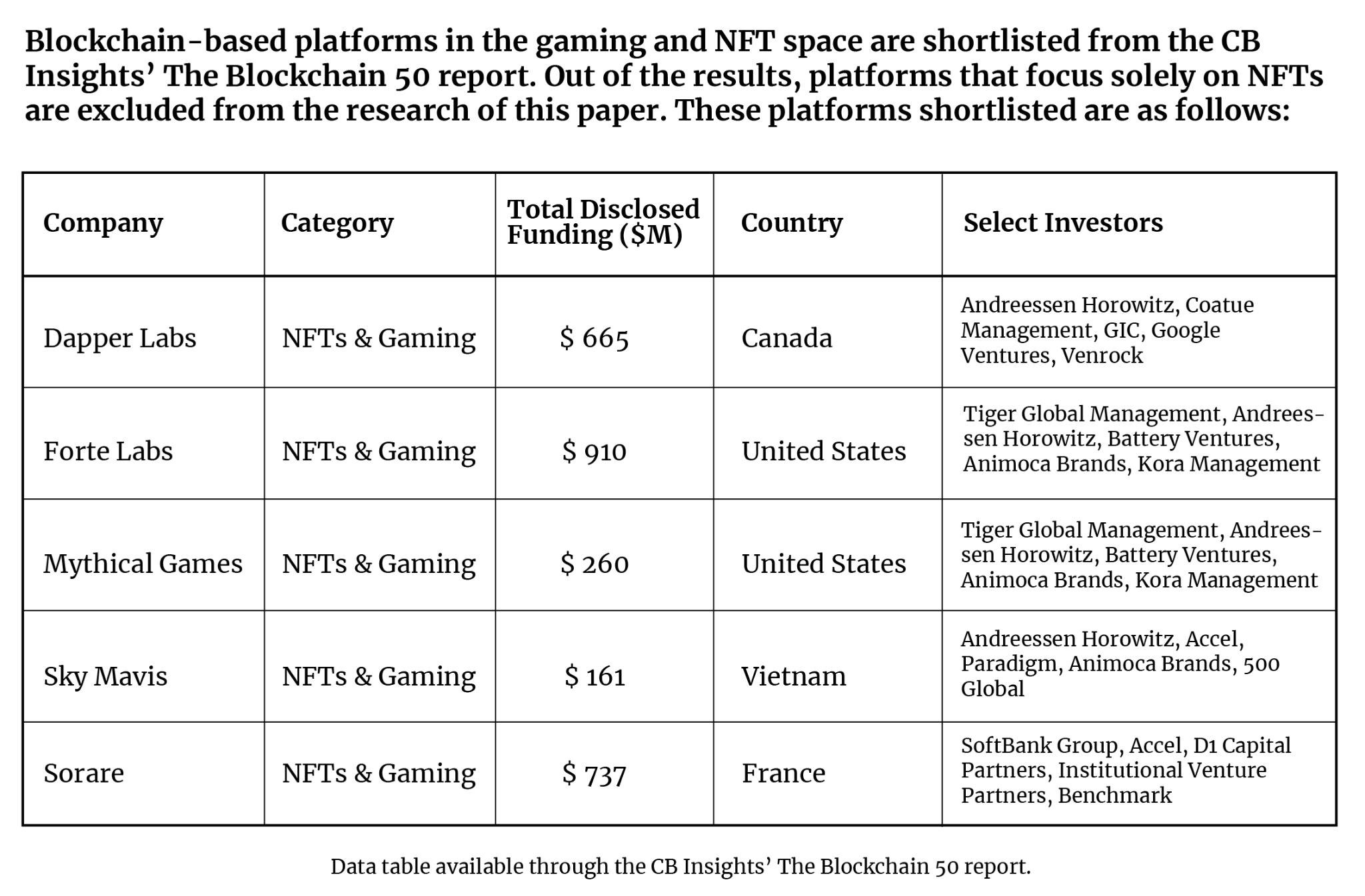
From analysing the platforms, there are two groups of stakeholders identified. These groups are platform enablers and platform users. (Fig 2)
Platform enablers help set up the platform, onboard users, define interactions, intermediate value exchange and ensure the smooth functioning of the platform
Platform users, as the name suggests, are the di�erent customer groups that use the platform to fulfill their needs.
To be classified as a platform, platform providers need at least two groups of customers who have very di�erent needs for which they would use the platform. (Evans and Schmalensee, 2016). Gaming and NFT platforms have three distinct groups of customers, these are gamers, investors, and game providers.
The needs analysis of the platform users highlights that platforms need to create in-direct network externalities Gamers will join the platform when they have a good collection of games to choose from, and game providers would also choose the platform based on how many gamers are on it.
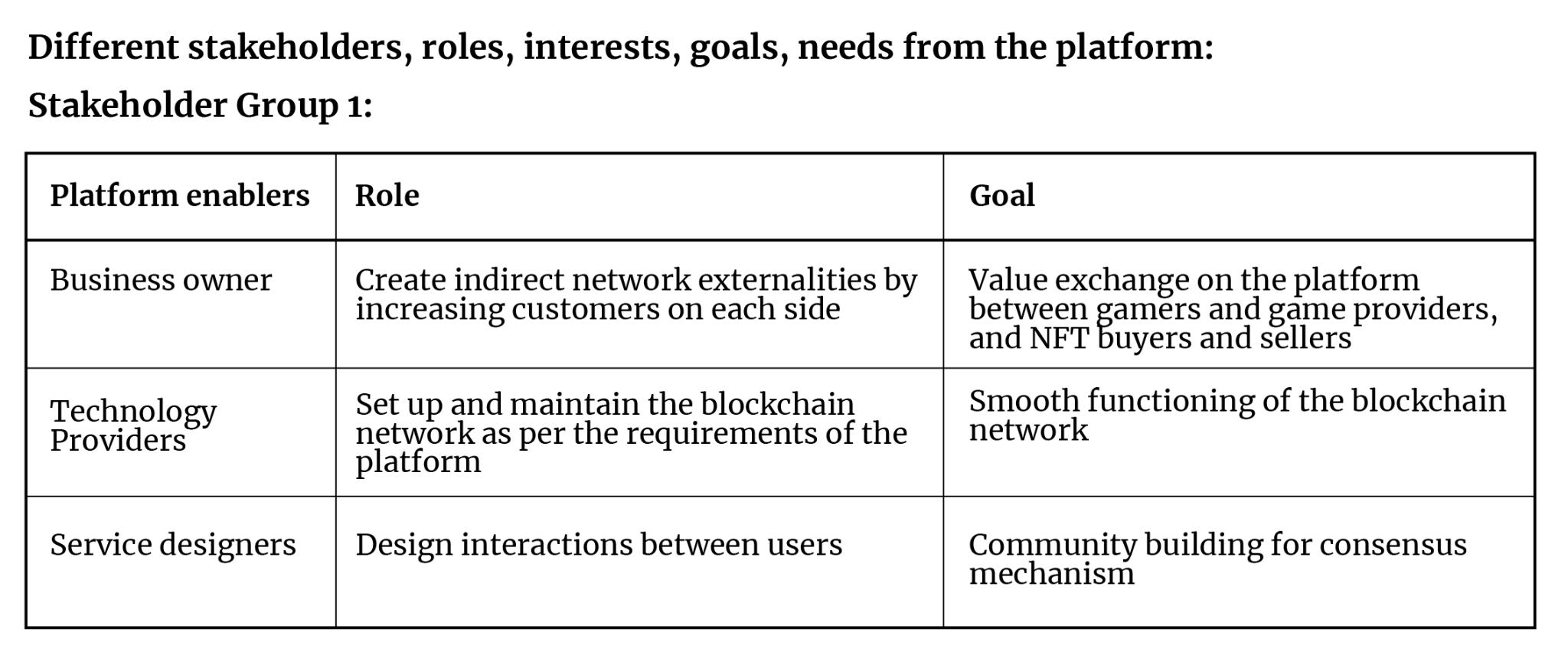
In the same way, investors will buy NFTs on the platform if there are many buyers who would buy the NFTs when they sell them. Platform providers must play matchmakers to match the right platform users to each other. (Täuscher and Laudien, 2018)
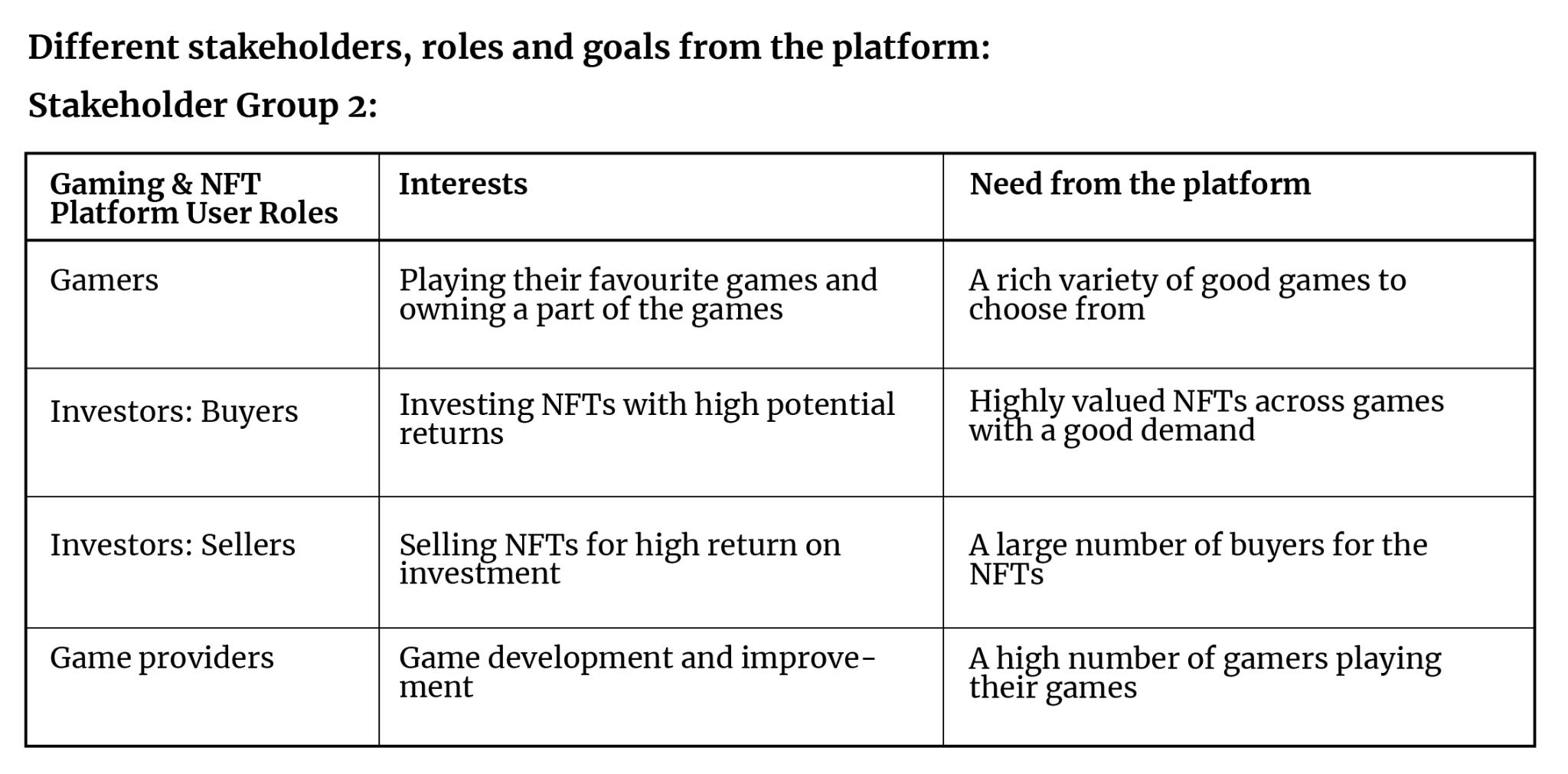
The current transactional service interactions in blockchain-based gaming and NFT platforms:
The importance of service interactions:
It is also not enough to rely on network externalities to grow the user base without providing a platform that can evolve with the market needs Service designers need to design all possible user interactions on the platform that can help create new value propositions for these platforms.
A consensus mechanism occurs when di�erent users work together to agree on issues unanimously. This in turn allows self-regulation of the platform when users are pivotal in the functioning of the platform.
Williams and Aitken (2011) view value co-creation as a ‘reciprocal process where value is delivered when all parties involved in the process realise their roles in the process and fulfill their responsibilities ’
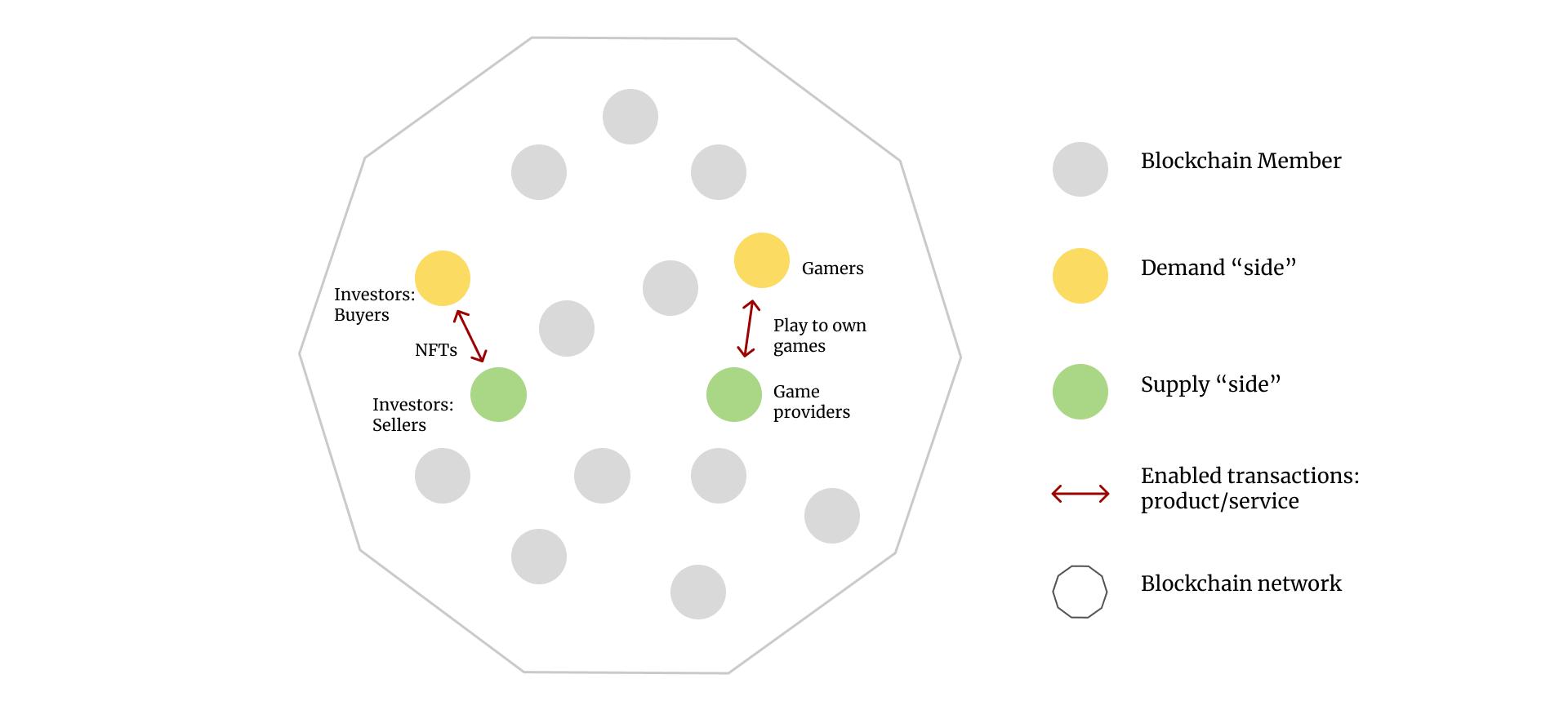
In an emerging space like Gaming & NFT, blockchain-based platforms should encourage platform users to participate in ways that allow them to be responsible for di�erent roles that help define how the platform should function.
To understand the possibilities for platforms focussed on Gaming and NFT, it is important to understand how platforms in other sectors have taken advantage of the blockchain network to design user roles and interactions.
In an analysis of di�erent blockchain platforms namely BitBoost, CyberMiles, Soma, Vanig, and Gamb (Trabucchi et al., 2020), there were more user types defined based on the role they can execute on the platforms. These user types are validators, arbitrators, and token holders.
Figure 4: Service interactions in gaming and NFT platforms today. Implications of Blockchain on Two-Sided Platform Framework (Trabucchi et al., 2020)Service designers can adapt these roles to define the service interactions on the Gaming and NFT blockchain platforms.
The development of blockchain platforms integrating Gaming and NFT as a service requires an in-depth understanding of what are the needs of stakeholders Since they are digital platforms, the only way to recognise new opportunities is by allowing users to interact with the platform and be instrumental in the decision-making of the platform.
This is why companies have identified the importance of value co-creation as they are trying to involve customers in not just the design phase but also in the development of the platforms. (Hollebeek et al.,2019).
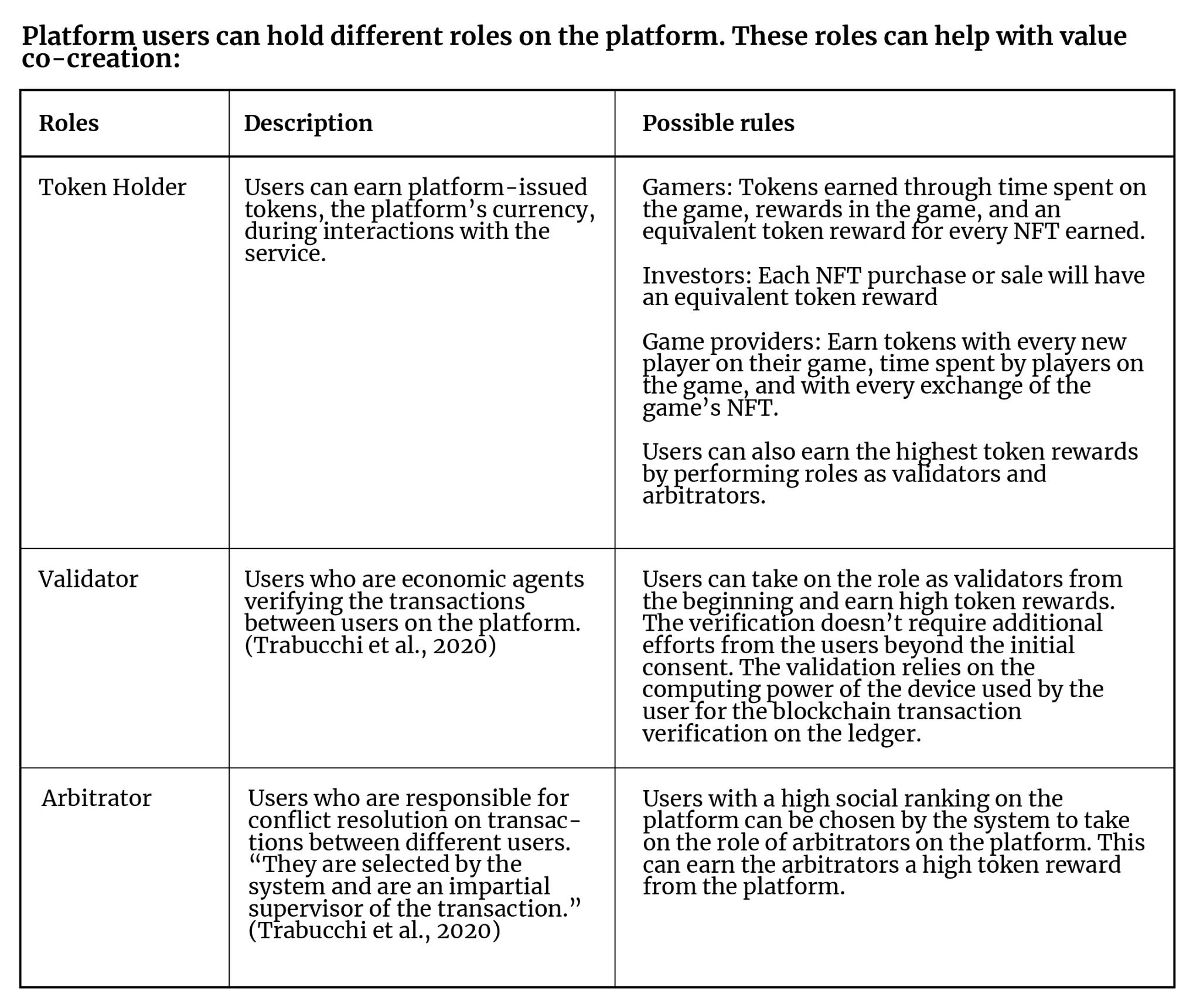
Tokens as incentives for service interaction:
Tokens allow users to have a stake in the platform. These tokens are rewarded to users as an incentive to encourage community building and provide voting rights to help them be a part of the growth of the platform. Implementing tokens would also help
Fig 5: Roles and rules for earning tokensusers regulate their behavior on the platform to continue their participation in the ecosystem
Tokens give autonomy to the network to self-regulate and enable trust in the system through a consensus mechanism to validate the interactions of other users on the platform.
The di�erent roles that users can take on the platform are as validators, arbiters, or simply token holders. This gives users the opportunity to have a bigger role in the system and can also increase the engagement of the users on the platform. The role of an arbitrator is the best example of how the service can help users take decisions on the platform and have a high level of interaction with the service. It also gives active users the power to shape the platform’s growth. (Trabucchi
et al., 2020)Service designers can design the experience for these di�erent roles to improve the possibilities of interactions and improve the ability of users to express themselves in the decision-making of the platform. Designers could map out the service interactions of these roles. Apart from defining individual roles, designers must also look at how users can participate in di�erent roles simultaneously like gaming, and then buying and selling their NFTs.
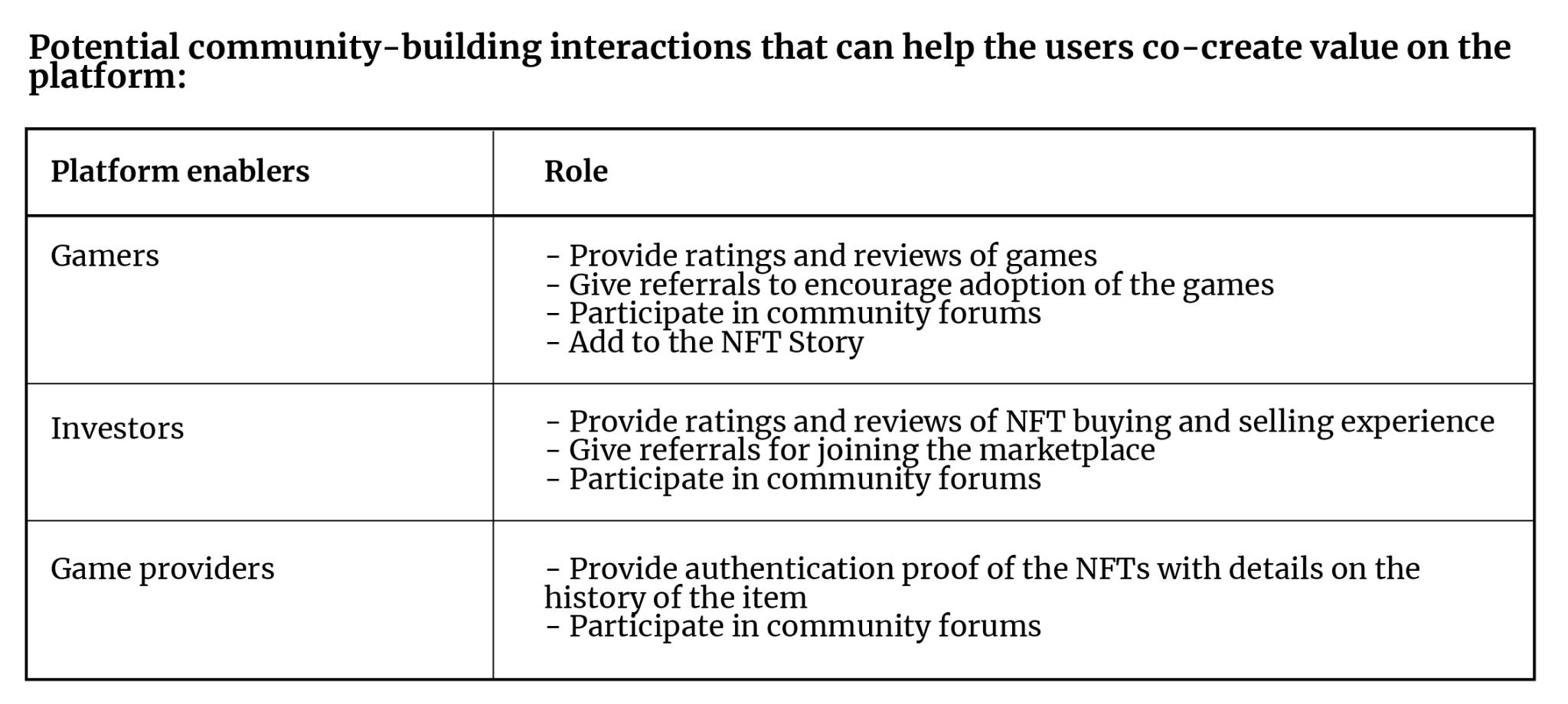 Fig 6: Potential service interactions through community-building
Fig 6: Potential service interactions through community-building
Today, tokens can be used for the open decision-making governance mechanism required by the platforms. These tokens can be used for voting on the development of the platform. Higher token verification gives better access to roles in forums and discussion groups like how social messaging platforms such as Discord and Reddit work.
This token system will incentivise users to engage more with the platform to increase their rank in the system to get better rewards. Higher engagement will also allow the platform to study the interactions of users to improve the experience on the platform.
Data flow or value exchange can happen through an exchange of value, money, information, products, and services.
There are di�erent ways users can help the platform become trustworthy and add value. Users can post reviews, and rate their interactions with other stakeholders. This could be reviews for games or their NFT buying & selling experience. Users can give referrals to potential users to join the platform. They can also participate in community forums by posting queries and providing answers.
Introducing NFTs to create multi-sides for value exchange:
Trends in other sectors utilising blockchain include authentication of the items. (Trabucchi et al., 2020) In this industry, NFTs could have authentication that allows users to read about the history of the game artefact, what it represents, who owned it over time, and other such information that can increase the value of the item. Users who own the item can also add a story of how they relate to that particular NFT,
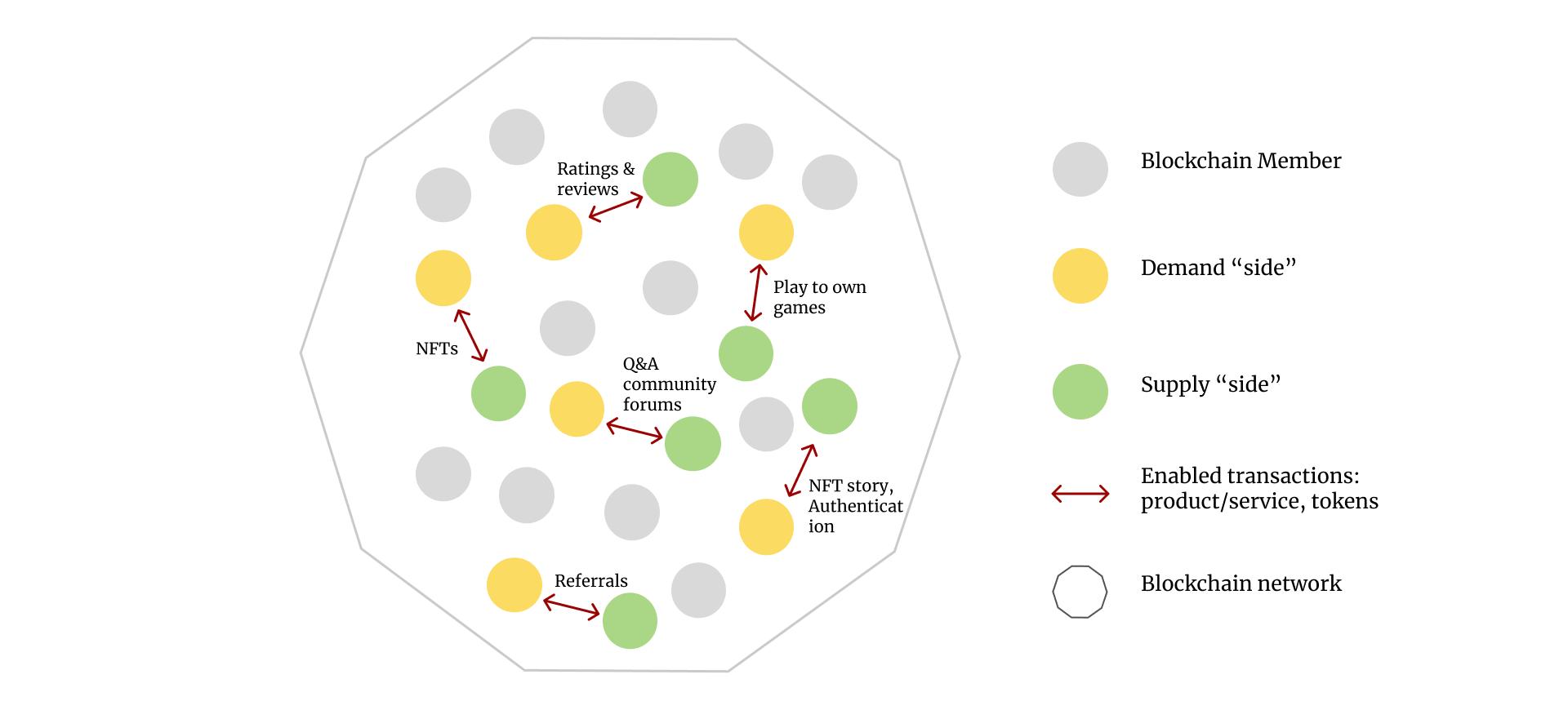 The implication of the proposed service interactions on blockchain-enabled gaming and NFT platforms for value co-creation:
Figure 7: Proposed service interactions in gaming and NFT platforms Implications of Blockchain on Two-Sided Platform Framework(Trabucchi et al., 2020)
The implication of the proposed service interactions on blockchain-enabled gaming and NFT platforms for value co-creation:
Figure 7: Proposed service interactions in gaming and NFT platforms Implications of Blockchain on Two-Sided Platform Framework(Trabucchi et al., 2020)
allowing user-generated value to be added to the artefacts. Service designers can leverage the operant skills of users such as the knowledge and skills that they possess to help users co-create value.
Gamers can be incentivised to add to the NFT story to receive more tokens. Since the NFTs are game items, users can upload their game replay of acquiring the item as a way to add to the NFT story. This can increase the value of NFT.
The role of platform providers to create service interactions that enable value co-creation:
Service designers should use the social exchange theory to design these incentives for users which posits that users will engage in an interaction if they feel like the benefits are higher than the costs. (Füller, 2010). If users feel suitably rewarded for their interaction, they will continue to interact on the platform In order for peer governance through the token system to work, service designers must make sure that users are engaged in a way that they don't see the ratings, reviews and other processes as an e�ort or an obligation but rather as an opportunity to gain rewards.
Through the consensus mechanism, users are more powerful because they have the power to make decisions on how the platform can serve their needs. This would satisfy their psychological need for belonging because they feel like they belong to a community which would motivate them to actively use the platform. This aligns with the self-determination theory in value co-creation that states the motivation for a user’s action depends on how satisfied they feel with respect to their psychological needs. (Deci and Ryan, 1980)
Platform providers are important as they work together to understand the data they have from all the user interactions that they can use to recognise what are the emerging needs of the users and where there is an opportunity to introduce more services to provide new value to the users.
Designers must design to involve all stakeholders in the interactions on the platform to stay true to the co-creation perspective. They must make all stakeholders responsible members as they participate in the platform.
As the platform provider and the customers build value for themselves, they would also build a strong relationship with each other While defining the roles and interactions of each of the stakeholders, service designers must also keep their best interests and needs in mind, which is why they should focus on maximising value for both, the platform provider and the customers.
Conclusion:
Interaction is the most important priority of platform businesses because that is where the value creation lies because of the nature of the shift from traditional companies that relied on building the products and services themselves to platform
businesses that simply act as intermediaries between di�erent groups of customers. In the platforms, users are responsible for self-regulating the ecosystem which is why their opinion is instrumental in how the service is delivered. This helps create high satisfaction and a sense of community among users. With the consensus mechanism that allows customers to participate in the decision-making of the platform, service designers can innovate new possibilities for serving the unmet needs of customers. The former uses co-creation to generate value and the latter uses co-innovation to create value.
By defining the roles and the interactions between di�erent actors using the service, service designers are not only helping improve the experience on the platform but also enabling moments for value co-creation for service innovation. Moving forward, service designers and researchers can continue to define the roles and interactions in more detail to better understand how the ecosystem can function. There is scope to develop methods that can help service designers to study user interaction data. Researchers can also explore what other features other than the ones listed in this paper that service designers can add to the platform to incentive more interaction, for more value co-creation.
References:
Abdul-Jabbar, S. (2022, April 14). Council post: Predictions for the blockchain industry in 2022. Forbes. Retrieved August 7, 2022, from
https://www forbes com/sites/forbesbusinesscouncil/2022/02/04/predictions-for-th e-blockchain-industry-in-2022/?sh=2a5ac5db685a
Buganza, T., Trabucchi, D., & Pellizzoni, E. (2019). Limitless personalisation: The role of Big Data in unveiling service opportunities. Technology Analysis & Strategic Management, 32(1), 58–70. https://doi.org/10.1080/09537325.2019.1634252
CB Insights. (2022). The complete list of Unicorn Companies. The Complete List Of Unicorn Companies. Retrieved April 7, 2022, from https://www.cbinsights.com/research-unicorn-companies
CB Insights. (2022, June 22). The blockchain 50: The Top Blockchain Companies of 2022. CB Insights Research. Retrieved August 8, 2022, from https://www.cbinsights.com/research/report/blockchain-technology-companies/
Christensen, C. M., Raynor, M., & McDonald, R. (2015, December). The big idea what is disruptive - innosight. What Is Disruptive Innovation? Retrieved August 24, 2022, from https://www.innosight.com/wp-content/uploads/2018/01/Innosight HBR What-is Disruptive-Innovation.pdf
De Vries, A. (2018). Bitcoin's growing energy problem. Joule, 2(5), 801–805. https://doi.org/10.1016/j.joule.2018.04.016
Deci, E.L. and Ryan, R.M. (1980), “Self-determination theory: when mind mediates behaviour”, The Journal of Mind and Behavior, pp. 33-43.
Fortune Business Insights. (2022, March). Blockchain Market Size, growth: Global Forecast Report [2029]. Blockchain Market Size, Growth | Global Forecast Report [2029]. Retrieved August 7, 2022, from https://www.fortunebusinessinsights.com/industry-reports/blockchain-market-100 072
Füller, J. (2010). Refining virtual co-creation from a consumer perspective. California Management Review, 52(2), 98–122. https://doi.org/10.1525/cmr.2010.52.2.98
Hollebeek, L.D., Srivastava, R.K. and Chen, T. (2019), “SD logic–informed customer engagement: integrative framework, revised fundamental propositions, and application to CRM”, Journal of the Academy of Marketing Science, Vol 47 No 1, pp 161-185.
Katz, M L , and C Shapiro 1985 Network externalities, competition, and compatibility. American Economic Review 75 (3): 424–40.
Manser Payne, E H , Peltier, J , & Barger, V A (2021) Enhancing the value co-creation process: Artificial Intelligence and Mobile Banking Service Platforms. Journal of Research in Interactive Marketing, 15(1), 68–85.
https://doi.org/10.1108/jrim-10-2020-0214
Rust, R. T., and M. Huang. 2014. “The Service Revolution and the Transformation of Marketing Science.” Marketing Science 33 (2): 206–221.
Saha, V., Goyal, P., & Jebarajakirthy, C. (2021). Value co-creation: A review of Literature and Future Research Agenda. Journal of Business & Industrial Marketing, 37(3), 612–628. https://doi.org/10.1108/jbim-01-2020-0017
Song, M., M. E. Parry, and T. Kawakami. 2009. Incorporating network externalities into the technology acceptance model Journal of Product Innovation Management 26 (3): 291–307.
Täuscher, K., and S. M. Laudien. 2018. Understanding platform business models: A mixed methods study of marketplaces. European Management Journal 36 (3): 319–29.
Trabucchi, D., Moretto, A., Buganza, T., & MacCormack, A. (2020). Disrupting the disruptors or enhancing them? how Blockchain Reshapes two‐sided platforms. Journal of Product Innovation Management, 37(6), 552–574. https://doi.org/10.1111/jpim.12557
Trabucchi, D., T. Buganza, and E. Pellizzoni. 2017. “Give Away Your Digital Services: Leveraging Big Data to Capture Value.” Research-Technology Management. Van
Eijk, N., R. Fahy, H. Van Til, P. Nooren, H. Stokking, and H. Gelevert. 2015. Digital platforms: An analytical framework for identifying and evaluating policy options. Delft, the Netherlands: TNO
Williams, J., & Aitken, R. (2011). The service-dominant logic of marketing and marketing ethics. Journal of Business Ethics, 102(3), 439–454. https://doi.org/10.1007/s10551-011-0823-z
Wise, J. (2022, July 20). How much is the gaming industry worth in 2022? (revenue & stats). EarthWeb. Retrieved August 7, 2022, from https://earthweb.com/how-much-is-the-gaming-industry-worth/ Xie, K., Y. Wu, J. Xiao, and Q. Hu. 2016. “Value co-Creation Between Firms and Customers: The Role of Big Data-Based Cooperative Assets.” Information & Management 53 (8): 1034–1048.
